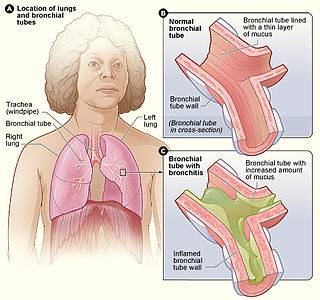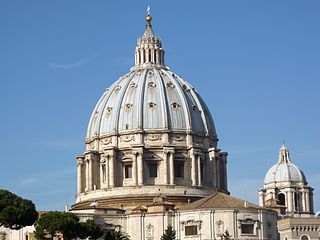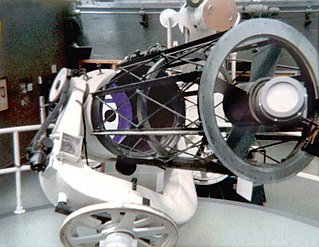
The Lick Observatory is an astronomical observatory, owned and operated by the University of California. It is situated on the summit of Mount Hamilton, in the Diablo Range just east of San Jose, California, US. The observatory is managed by the University of California Observatories, with headquarters on the University of California, Santa Cruz campus, where its scientific staff moved in the mid-1960s. It is named after James Lick.

William Lassell, was an English merchant and astronomer. He is remembered for his improvements to the reflecting telescope and his ensuing discoveries of four planetary satellites.

Boyden Observatory is an astronomical research observatory and science education centre located in Maselspoort, 20 kilometres (12 mi) north-east of the city of Bloemfontein in Free State, South Africa. The observatory is managed by the Physics Department of the University of the Free State (UFS). The Friends of Boyden assist the observatory as a public support group, organising open evenings and protecting its public interest. Boyden also makes use of members of ASSA Bloemfontein Centre, the amateur astronomy club of the city, for presenters and telescope assistants.
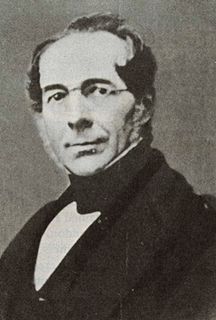
William Rutter Dawes was an English astronomer.
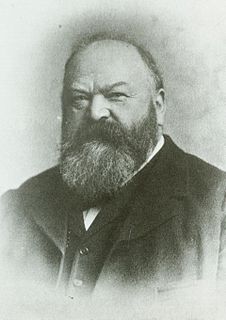
Andrew Ainslie Common FRS (1841–1903) was an English amateur astronomer best known for his pioneering work in astrophotography.
Markree Observatory was an astronomical observatory in County Sligo, Ireland. The asteroid 9 Metis was discovered from this observatory in 1848.
William Sadler Franks was a British astronomer.
William Herbert Steavenson FRAS was an English amateur astronomer.
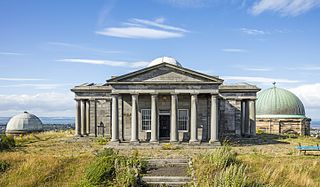
The City Observatory is an astronomical observatory on Calton Hill in Edinburgh, Scotland. It is also known as the Calton Hill Observatory.

Melbourne Observatory was founded in 1862 to serve as a scientific research institution for the rapidly growing city of Melbourne, the capital of the colony of Victoria. The observatory was tasked by the Victorian government with maintaining an accurate time reference for the colony through observations of stars using a transit telescope as well as general astronomical research.

The University of Illinois Astronomical Observatory, located at 901 S. Mathews Avenue in Urbana, Illinois, on the campus of the University of Illinois at Urbana–Champaign, was built in 1896, and was designed by Charles A. Gunn. It has been listed on the National Register of Historic Places since November 6, 1986, and on December 20, 1989, was designated a National Historic Landmark.

The Toronto Magnetic and Meteorological Observatory is a historical observatory located on the grounds of the University of Toronto, in Toronto, Ontario, Canada. The original building was constructed in 1840 as part of a worldwide research project run by Edward Sabine to determine the cause of fluctuations in magnetic declination. Measurements from the Toronto site demonstrated that sunspots were responsible for this effect on Earth's magnetic field. When this project concluded in 1853, the observatory was greatly expanded by the Canadian government and served as the country's primary meteorological station and official timekeeper for over fifty years. The observatory is considered the birthplace of Canadian astronomy.

The Shuckburgh telescope or Shuckburgh equatorial refracting telescope was a 4.1 inch diameter aperture telescope on an equatorial mount completed in 1791 for Sir George Shuckburgh (1751–1804) in Warwickshire, England, and built by British instrument maker Jesse Ramsden (1735–1800). It was transferred to the Royal Observatory, Greenwich in 1811 and the London Science Museum in 1929. Even though it was not particularly successful, its design was influential. It was one of the larger achromatic doublet telescopes at the time, and one of the largest to have an equatorial mount.
William Edward Wilson was an Irish astronomer.
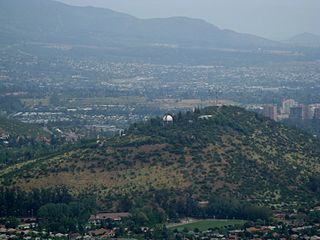
The National Astronomical Observatory of Chile is an astronomical observatory owned and operated by the Department of Astronomy of the University of Chile (UCh). It is located on Cerro Calán, a hill in the commune of Las Condes. The commune is an eastern suburb of Santiago located in Santiago Province of the Santiago Metropolitan Region. OAN was founded in 1852 and became a part of UCh in 1927. The facility on Cerro Calán was completed in 1962.

The Royal Observatory, Cape of Good Hope, is the oldest continuously existing scientific institution in South Africa. Founded by the British Board of Longitude in 1820, it now forms the headquarters building of the South African Astronomical Observatory.
The Astronomy Centre, also known as the Amateur Astronomy Centre, is an astronomical observatory located in northern England which is run by experienced amateur astronomers and is open to the public at certain times.

UCL Observatory at Mill Hill in London is an astronomical teaching observatory. It is part of the Department of Physics and Astronomy at University College London.
Joseph Gurney Barclay FRAS was the son of Robert and Elizabeth Barclay. Joseph Gurney Barclay followed the banking profession for more than fifty years. In his later career he was head of the Barclay & Bevan bank and retired at the age of 80 when his bank amalgamated with others into a limited company in 1896. He was also a life member of the Meteorological Society.





